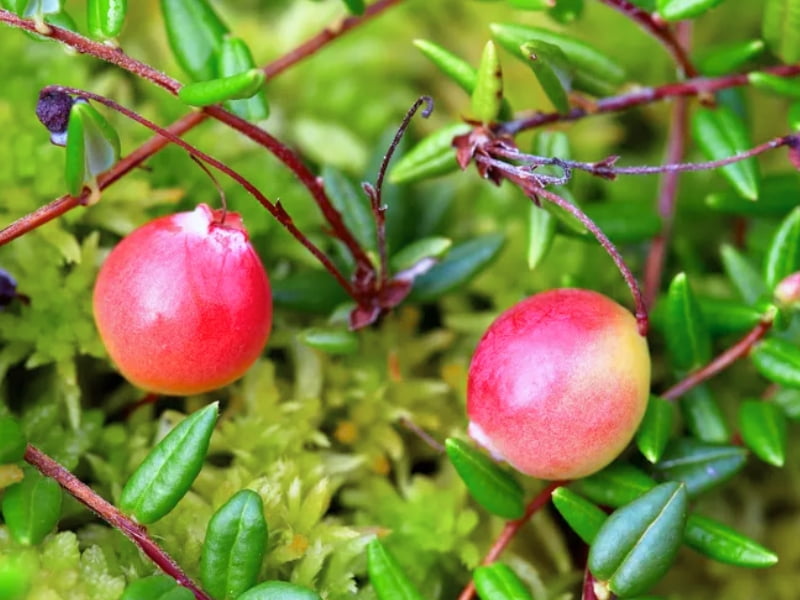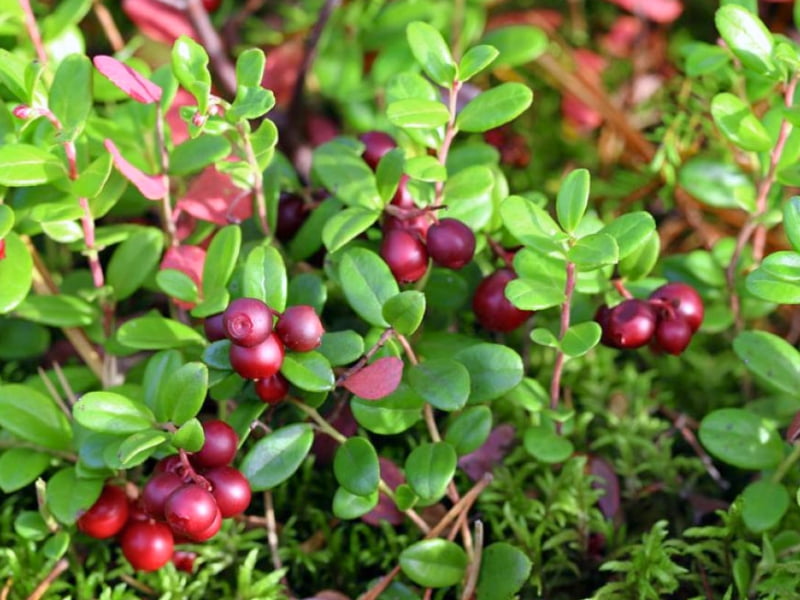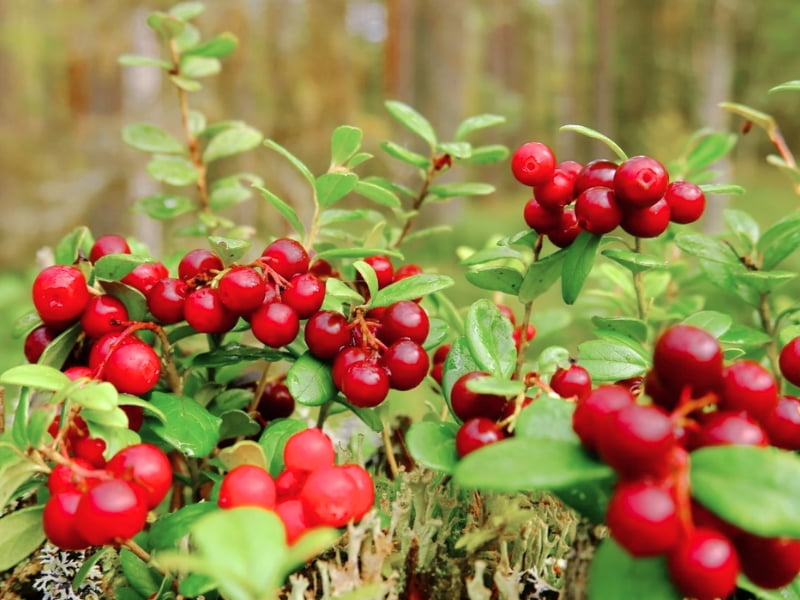Cranberry plants, also commonly known as American cranberry, bog cranberry, and low cranberry, are fascinating, low-growing, woody, perennial vines belonging to the Vaccinium genus and oxycoccus subgenus, scientifically known as Vaccinium macrocarpon. These native North American plants offer a unique opportunity to grow tart, nutritious berries right in your own garden, provided you can meet their specific needs.
This guide will provide you everything you need to succeed with your cranberry plant. We’ll cover aspects like buying cranberries, finding local cranberry farms near you.

What is Cranberry Plant? Botany and Origins
The cranberry plant is a fascinating species with a unique history and specific botanical characteristics. Native to North America, specifically the northeastern United States and southeastern Canada, cranberries have been cultivated for centuries. The indigenous peoples of these regions, such as the Wampanoag and Lenape, utilized cranberries for food, medicine, and dye long before European colonization. They introduced the berry to the Pilgrims, who quickly incorporated it into their diet.
| Common names | American Cranberry, Bog Cranberry, Low Cranberry, Northern Cranberry, Small Cranberry. |
| Botanical name | Vaccinium macrocarpon |
| Family | Ericaceae (Heath Family) |
| Genus | Vaccinium |
| Species | macrocarpon |
| Origin | North America |
| Native | Eastern North America (USA and Canada) |
| Life cycle | Perennial |
| Plant type | Woody, evergreen vine (groundcover) |
| Hardiness zone | 2-7 (depending on variety) |
| Sunlight | Full Sun (6-8 hours minimum) |
| Maintenance | Moderate |
| Water | Moderate to High (consistent moisture) |
| Drainage | Well-Drained, Essential |
| Spacing | 1-2 ft. between plants, 2-3 ft. between rows |
| Flowering period | Late Spring to Early Summer (May-June) |
| Harvest period | Fall (September – November, depending on variety) |
| Height | 2-8 inches (low-growing) |
| Spread | 1-4 feet (can spread indefinitely via runners) |
| Growth rate | Moderate |
| Flower color | Pinkish-White |
| Fruit color | Red (when ripe; starts white) |
| Leaf color | Green (turning reddish-bronze in winter) |
| Stem color | Brown |
| Flower benefit | Attracts pollinators (bees) |
| Fruit benefit | Edible, nutritious berries; source of antioxidants and potential health benefits. |
| Garden style | Edible Garden, Groundcover, Native Plant Garden, Bog Garden (specialized) |
| Uses | Food production (berries), ornamental groundcover, wildlife food source (in natural settings) |
| Soil pH | Acidic (4.0 – 5.5) |
| Soil type | Sandy, well-drained, rich in organic matter (peat moss is beneficial) |
| Chill hours | 1,500 – 2,000 (Varies by cultivar) |
| Special features | Requires acidic soil; unique harvesting methods (wet and dry); traditional food source with historical significance. |
- Botanical Classification:
- Kingdom: Plantae
- Division: Magnoliophyta
- Class: Magnoliopsida
- Order: Ericales
- Family: Ericaceae
- Genus: Vaccinium
- Subgenus: Oxycoccus
- Species: Vaccinium macrocarpon
- Plant Morphology:
- Growth Habit: Cranberry plants are low-growing, trailing vines, often described as evergreen groundcover. They spread via stolons (above-ground runners) and rhizomes (underground stems).
- Leaves: The leaves are small, elliptical, and leathery, typically dark green in color. They turn reddish-bronze in the winter.
- Flowers: The flowers are small, pinkish-white, and bell-shaped, appearing in late spring to early summer. They are pollinated by bees.
- Fruit: The fruit is a berry that starts out white and turns a deep red when ripe. The size and color can vary slightly depending on the cultivar. Cranberries contain air pockets, which cause them to float in water – a characteristic crucial for the traditional wet harvesting method.
- Historical Significance:
- Indigenous Use: Native Americans used cranberries in various ways, including making pemmican (a mixture of dried meat, fat, and berries), treating wounds, and creating dyes for clothing and blankets.
- Early American Cultivation: Commercial cranberry cultivation began in the early 19th century in Massachusetts. Henry Hall, a veteran of the Revolutionary War, is credited with being the first to cultivate cranberries commercially in Dennis, Massachusetts, around 1816. He noticed that wild cranberries grew better when sand blew over them, which led to the practice of sanding cranberry bogs.
- Modern Cultivation: Today, the leading cranberry-producing states in the US include Wisconsin, Massachusetts, New Jersey, Oregon, and Washington. Canada is also a significant producer, particularly in British Columbia and Quebec.
Ideal Growing Conditions for Cranberry Plants
Successfully growing cranberries requires mimicking their natural habitat, which is typically acidic bogs. While you don’t need to create a full-scale bog in your backyard, understanding the specific environmental requirements is crucial.
- Soil Acidity (pH): This is perhaps the most critical factor. Cranberry plants thrive in highly acidic soil with a pH between 4.0 and 5.5. Most garden soils are not naturally this acidic, so soil amendment is almost always necessary.
- Testing Soil pH: Use a soil testing kit (readily available at garden centers) to determine your soil’s current pH.
- Lowering Soil pH: Amend the soil with elemental sulfur or sphagnum peat moss. Elemental sulfur is a slow-release option, while peat moss provides immediate acidity and improves soil structure. The amount needed will depend on your soil’s initial pH and the desired pH level. Follow package instructions carefully. A general guideline is to apply 1-2 pounds of elemental sulfur per 100 square feet to lower the pH by one point.
- Soil Type and Drainage: Cranberry plants prefer sandy, well-drained soil that is rich in organic matter. While they need consistent moisture, they do not tolerate waterlogged conditions.
- Improving Drainage: If your soil is heavy clay, amend it generously with compost, peat moss, and sand to improve drainage.
- Creating Raised Beds: Consider planting cranberries in raised beds filled with an acidic soil mix. This provides excellent drainage and allows for better control over soil conditions.
- Sunlight: Cranberry plants need full sun, meaning at least six to eight hours of direct sunlight per day, for optimal growth and fruit production.
- Water: Consistent moisture is essential, especially during the growing season. Cranberries require about 1 inch of water per week, either from rainfall or irrigation.
- Irrigation Methods: Drip irrigation or soaker hoses are ideal, as they deliver water directly to the roots and minimize the risk of fungal diseases.
- Water Quality: Avoid using hard water (water with high mineral content), as it can raise the soil pH over time. If you have hard water, consider collecting rainwater for irrigation.
- Climate: Cranberries are cold-hardy plants, typically thriving in USDA hardiness zones 2 through 7. They require a certain number of chill hours (hours below 45°F / 7°C) during the winter to break dormancy and produce fruit. The required chill hours vary by cultivar, but most need between 1,500 and 2,000 hours.
- Air Circulation: Good air circulation helps prevent fungal diseases. Avoid planting cranberries in overly sheltered locations.

Step-by-Step Guide to Planting Cranberry Plants
Planting cranberry plants requires careful preparation and attention to detail. Here’s a step-by-step guide:
- Choose the Right Time: The best time to plant cranberry plants is in the spring, after the last frost, or in the fall, at least six weeks before the first expected frost.
- Select a Planting Site: Choose a location that meets the ideal growing conditions described above (full sun, acidic soil, good drainage).
- Prepare the Soil:
- Clear the Area: Remove any weeds, grass, and debris from the planting area.
- Test Soil pH: As mentioned earlier, test the soil pH and amend it as needed to achieve a pH between 4.0 and 5.5.
- Amend the Soil: Incorporate a generous amount of peat moss, compost, and sand into the soil to improve drainage and acidity.
- Create a Planting Bed: Consider creating a raised bed, especially if your soil is poorly drained. A raised bed should be at least 12 inches deep and filled with an acidic soil mix. A good mix is 1/3 peat moss, 1/3 sand, and 1/3 existing garden soil (if it’s not heavy clay).
- Obtain Cranberry Plants: Purchase healthy cranberry plants from a reputable nursery or garden center, like those found through Gardencenterpoint.com. Look for plants that are well-rooted and free of diseases or pests.
- Plant the Cranberries:
- Spacing: Space the plants 1 to 2 feet apart in rows that are 2 to 3 feet apart.
- Digging the Hole: Dig a hole that is slightly larger than the root ball of the plant.
- Planting Depth: Plant the cranberry at the same depth it was growing in the container. Do not bury the crown of the plant (where the stems meet the roots).
- Backfill: Gently backfill the hole with the amended soil, making sure to firm the soil around the roots.
- Sanding: Spread approximately a 1/2 inch of sand around the base of the cranberry plant.
- Water Thoroughly: Water the newly planted cranberries thoroughly to settle the soil and hydrate the roots.
- Mulch (Optional): Apply a layer of acidic mulch, such as pine needles or shredded pine bark, around the plants. Mulch helps retain moisture, suppress weeds, and maintain soil acidity.
Caring for Your Cranberry Plant
Ongoing care is essential for healthy cranberry plants and abundant fruit production.
- Watering:
- Frequency: Water consistently, providing about 1 inch of water per week. Increase watering during hot, dry periods.
- Method: Use drip irrigation or soaker hoses to avoid wetting the foliage, which can increase the risk of fungal diseases.
- Monitor Soil Moisture: Check the soil moisture regularly by inserting your finger a few inches into the soil. If it feels dry, it’s time to water.
- Fertilizing:
- Type of Fertilizer: Use a fertilizer formulated for acid-loving plants, such as those used for azaleas or rhododendrons. Avoid fertilizers high in nitrogen, as they can promote excessive vegetative growth at the expense of fruit production.
- Timing: Fertilize in the spring, after new growth emerges, and again in early summer. Follow package instructions for application rates.
- Soil Testing: Conduct a soil test every few years to determine nutrient levels and adjust fertilization accordingly.
- Pruning:
- Purpose: Pruning helps maintain plant shape, improve air circulation, and promote fruit production.
- Timing: Prune in late winter or early spring, before new growth begins.
- Technique:
- Remove any dead, damaged, or diseased wood.
- Thin out crowded or crossing branches.
- Prune back runners that have extended beyond the desired growing area.
- Lightly shear the tops of the plants to encourage bushier growth.
- Weed Control:
- Importance: Weeds compete with cranberry plants for water, nutrients, and sunlight.
- Methods:
- Hand-Weeding: Regularly remove weeds by hand, especially when they are young.
- Mulching: Apply a thick layer of mulch to suppress weed growth.
- Herbicides (Use with Caution): If necessary, use a pre-emergent herbicide labeled for use around cranberry plants. Follow label instructions carefully.
Pest and Disease Management for Cranberry Plants
Cranberry plants are susceptible to several pests and diseases. Regular monitoring and preventative measures are key to minimizing problems.
- Common Pests:
- Cranberry Fruitworm: This is a major pest of cranberries. The larvae bore into the fruit, causing it to rot.
- Control: Monitor for adult moths using pheromone traps. Apply insecticides labeled for cranberry fruitworm control if necessary. Follow label instructions carefully.
- Cranberry Weevil: This weevil feeds on the leaves and buds of cranberry plants.
- Control: Handpick weevils if populations are low. Apply insecticides labeled for cranberry weevil control if necessary.
- Sparganothis Fruitworm: The larvae of this moth feed on the leaves and fruit of cranberry plants.
- Control: Monitor for adult moths using pheromone traps. Apply insecticides labeled for Sparganothis fruitworm control if necessary.
- Cranberry Fruitworm: This is a major pest of cranberries. The larvae bore into the fruit, causing it to rot.
- Common Diseases:
- Fruit Rot: Several fungal diseases can cause fruit rot, including early rot, bitter rot, and blotch rot.
- Prevention: Ensure good air circulation, avoid overhead watering, and remove infected fruit promptly.
- Control: Apply fungicides labeled for fruit rot control if necessary.
- Upright Dieback: This fungal disease causes the upright stems of cranberry plants to die back.
- Prevention: Plant disease-resistant cultivars, ensure good air circulation, and avoid over-fertilizing.
- Control: Prune out infected stems and apply fungicides labeled for upright dieback control if necessary.
- Fruit Rot: Several fungal diseases can cause fruit rot, including early rot, bitter rot, and blotch rot.
- Integrated Pest Management (IPM): IPM is a holistic approach to pest and disease management that emphasizes prevention and the use of least-toxic control methods. It involves:
- Monitoring: Regularly inspect plants for signs of pests and diseases.
- Cultural Practices: Use good cultural practices, such as proper watering, fertilizing, and pruning, to keep plants healthy and less susceptible to problems.
- Biological Control: Encourage beneficial insects, such as ladybugs and lacewings, that prey on pests.
- Chemical Control (Use as a Last Resort): If necessary, use pesticides and fungicides labeled for cranberry plants. Choose the least-toxic option and follow label instructions carefully.
Harvesting and Storing Your Cranberry Bounty
Harvesting cranberries is a rewarding experience. The traditional wet harvesting method, used in commercial cranberry bogs, is fascinating to watch, but home gardeners typically use the dry harvesting method.
- When to Harvest: Cranberries are typically ready for harvest in the fall, from September to November, depending on the cultivar and your location. The berries should be a deep red color and firm to the touch.
- Harvesting Methods:
- Dry Harvesting: This is the most common method for home gardeners. Simply handpick the berries from the vines.
- Wet Harvesting (Commercial Method): This method is used in commercial cranberry bogs. The bogs are flooded with water, and machines are used to agitate the vines, causing the berries to float to the surface. The berries are then collected using booms and conveyors. This method takes advantage of the air pockets within the cranberries.
- Storing Cranberries:
- Fresh Storage: Fresh cranberries can be stored in the refrigerator for up to four weeks. Place them in an airtight container or plastic bag.
- Freezing: Cranberries freeze very well. Spread them in a single layer on a baking sheet and freeze until solid. Then, transfer them to freezer bags or containers. Frozen cranberries can be stored for up to a year.
- Drying: Cranberries can also be dried. Use a food dehydrator or an oven set to a low temperature. Dried cranberries can be stored in an airtight container for several months.
Uses and Benefits of Cranberries
Cranberries are not only delicious but also packed with nutrients and health benefits.
- Culinary Uses:
- Cranberry Sauce: A classic Thanksgiving side dish.
- Juice: Cranberry juice is a popular beverage.
- Baked Goods: Cranberries are often used in muffins, breads, and cookies.
- Salads: Dried cranberries add a sweet and tart flavor to salads.
- Snacks: Dried cranberries are a healthy and convenient snack.
- Health Benefits:
- Urinary Tract Health: One of cranberries’ most well-known benefits is their potential to help prevent urinary tract infections (UTIs). Research suggests that compounds in cranberries, called proanthocyanidins (PACs), can prevent bacteria, particularly E. coli, from adhering to the walls of the urinary tract. This can reduce the risk of infection. A study published in the American Journal of Clinical Nutrition found that women who consumed cranberry products had a lower risk of UTIs. (Source: Jepson RG, Williams G, Craig JC. Cranberries for preventing urinary tract infections. Cochrane Database Syst Rev. 2012 Oct 17;10:CD001321.)
- Antioxidant Properties: Cranberries are rich in antioxidants, which help protect the body against damage from free radicals. Free radicals are unstable molecules that can contribute to aging and chronic diseases.
- Heart Health: Some studies suggest that cranberries may have benefits for heart health, such as lowering blood pressure and improving cholesterol levels.
- Anti-inflammatory Effects: Cranberries have anti-inflammatory properties, which may help reduce the risk of certain chronic diseases.
- Rich in Vitamin C and Fiber

Cranberry Plant Varieties
Choosing the right cranberry variety is a crucial step in ensuring a successful harvest and enjoying the unique characteristics of these tart berries. Several cultivars have been developed over the years, each with distinct traits related to growth habit, fruit size, color, flavor, disease resistance, and harvest timing. Gardencenterpoint.com provides this guide to help you navigate the options and select the best variety for your garden and needs. Factors like your climate (USDA Hardiness Zone and chill hours), local pest and disease pressures, and personal preferences for berry characteristics should all influence your decision.
Understanding Key Characteristics
Before diving into specific varieties, it’s helpful to understand the key characteristics that differentiate cranberry cultivars:
- Harvest Time: Cranberries are categorized as early-season, mid-season, or late-season varieties. Early-season varieties ripen first, typically in September, while late-season varieties ripen later, often in October or even early November. Choosing varieties with different harvest times can extend your cranberry season.
- Fruit Size and Color: Berry size can vary from small to large, and the color can range from light red to a deep, almost black-red.
- Flavor: While all cranberries are tart, some varieties have a more pronounced tartness than others. Some also have subtle differences in sweetness and overall flavor complexity.
- Growth Habit: While all cranberries are low-growing vines, some varieties have a more upright growth habit, while others are more sprawling. This can affect planting density and overall management.
- Disease Resistance: Some cultivars have been specifically bred for resistance to common cranberry diseases, such as fruit rot and upright dieback. This is a particularly important consideration if these diseases are prevalent in your area.
- Chill Hours: Cranberries require a certain number of chill hours (hours below 45°F / 7°C) during the winter to break dormancy and produce fruit. The required chill hours vary by cultivar. Make sure the variety you choose is suitable for your climate’s chill hour accumulation.
- Yield: Some varieties of cranberries may be more vigorous growers, leading to better overall yields when compared to others.
Popular Cranberry Varieties
Here’s a closer look at some of the most popular and readily available cranberry varieties:
- ‘Early Black’:
- Harvest Time: Early season (September).
- Fruit: Small to medium-sized, dark red to almost black berries.
- Flavor: Intensely tart flavor.
- Growth Habit: Relatively upright growth.
- Disease Resistance: Moderate disease resistance.
- Chill Hours: Requires around 1,500 chill hours.
- Notes: One of the earliest ripening varieties, ‘Early Black’ is a good choice for gardeners in cooler climates with shorter growing seasons. Its dark color makes it visually appealing.
- ‘Howes’:
- Harvest Time: Mid-season (late September to early October).
- Fruit: Medium to large, bright red berries.
- Flavor: Classic cranberry flavor, with a good balance of tartness and sweetness.
- Growth Habit: Spreading growth habit.
- Disease Resistance: Good disease resistance, particularly to fruit rot.
- Chill Hours: Requires around 1,800 chill hours.
- Notes: ‘Howes’ is a popular variety known for its good flavor, reliable yields, and keeping quality. It’s a good all-around choice for home gardeners.
- ‘Stevens’:
- Harvest Time: Late season (October).
- Fruit: Large, bright red berries.
- Flavor: Tart flavor.
- Growth Habit: Vigorous, spreading growth habit.
- Disease Resistance: Excellent disease resistance, particularly to fruit rot and upright dieback.
- Chill Hours: Requires around 2,000 chill hours.
- Notes: ‘Stevens’ is the most widely grown commercial cranberry variety in North America, prized for its high yields, disease resistance, and large fruit size. It’s a good choice for gardeners in areas with longer growing seasons.
- ‘Pilgrim’:
- Harvest Time: Late season (October).
- Fruit: Very large, dark red berries.
- Flavor: Tart flavor.
- Growth Habit: Spreading growth habit.
- Disease Resistance: Good disease resistance.
- Chill Hours: Requires around 2,000 chill hours.
- Notes: ‘Pilgrim’ is known for its exceptionally large fruit size, making it a visually impressive variety.
- ‘Ben Lear’:
- Harvest Time: Early season (September).
- Fruit: Medium-sized, dark red berries.
- Flavor: Tart flavor.
- Growth Habit: Spreading growth habit.
- Disease Resistance: Good disease resistance.
- Chill Hours: Requires around 1,500 chill hours.
- Notes: ‘Ben Lear’ is another early-season variety that is well-suited to cooler climates. It is known for its good disease resistance and consistent yields.
- ‘Crimson Queen’:
- Harvest Time: Mid to late season.
- Fruit: Large, bright red berries.
- Flavor: Sweet, with less tartness.
- Growth Habit: Strong vine growth.
- Disease Resistance: Very resistant.
- Chill Hours: Requires around 1500 chill hours.
- Notes: Released by Rutgers University in 2005, this newer variety has rapidly gained popularity.
- ‘Demoranville’:
- Harvest Time: Early Season.
- Fruit: Medium sized, dark red berries.
- Flavor: Tart.
- Growth Habit: Spreading.
- Disease Resistance: Good.
- Chill Hours: Requires around 1500 chill hours.
- Notes: A variety that is good for cooler climates.
Variety Selection Table
| Variety | Harvest Time | Fruit Size | Fruit Color | Flavor | Chill Hours | Notes |
| ‘Early Black’ | Early (Sept) | Small-Medium | Dark Red | Very Tart | 1,500 | Good for short growing seasons; visually appealing. |
| ‘Howes’ | Mid (Sept-Oct) | Medium-Large | Bright Red | Balanced | 1,800 | Good all-around choice; reliable yields; good keeping quality. |
| ‘Stevens’ | Late (Oct) | Large | Bright Red | Tart | 2,000 | Widely grown commercially; high yields; disease resistant. |
| ‘Pilgrim’ | Late (Oct) | Very Large | Dark Red | Tart | 2,000 | Exceptionally large fruit size. |
| ‘Ben Lear’ | Early (Sept) | Medium | Dark Red | Tart | 1,500 | Good for cooler climates; consistent yields. |
| ‘Crimson Queen’ | Mid-Late | Large | Bright Red | Sweet | 1,500 | Newer Variety, quickly gaining popularity. |
| ‘Demoranville’ | Early | Medium | Dark Red | Tart | 1,500 | Good for cooler climates. |
Making Your Choice: Key Considerations
- Local Climate: Ensure the variety you choose is suitable for your USDA Hardiness Zone and that your area receives enough chill hours for that variety to thrive.
- Disease Pressure: If specific cranberry diseases are common in your region, prioritize disease-resistant varieties.
- Personal Preference: Consider your preferred berry size, color, and flavor profile.
- Space Availability: The growth habit of the variety (upright vs. spreading) can influence how much space you’ll need.
- Pollination: While cranberries are self-pollinating, the presence of bees dramatically increases yields.

Leave a Reply